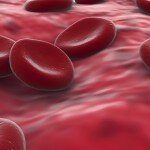 Outside our body Nitric Oxide is considered to be an environmental pollutant. Inside our body it is one of the most important, if not THE most important signaling molecule for the cardiovascular system. It even plays a role in helping to reduce the symptoms of sickle cell anemia.
Outside our body Nitric Oxide is considered to be an environmental pollutant. Inside our body it is one of the most important, if not THE most important signaling molecule for the cardiovascular system. It even plays a role in helping to reduce the symptoms of sickle cell anemia.
Sickle cell anemia primarily affects people of African, Mediterranean, Middle Eastern, and Asian Indian ancestry. Additionally, there is a growing segment of the Latino-American population particularly those of Caribbean, Central American and South American ancestry that are becoming susceptible to this hereditary disease. It is estimated that one out of every 400 births has this disease. (Please see my article “African Americans and Sickle Cell Anemia!” for a basic understanding of this disease.)
Recent Research – The Important of Nitric Oxide!
Researchers at Duke University and Howard Hughes Medical Institute recently discovered one of the keys to the cause of pain in sickle cell disease. Their findings were reported in the January 31, 2005 Proceedings of the National Academy of Sciences. Their research showed that when normal red blood cells move through the arteries they release a signaling molecule that tells the arterial walls to expand. The signaling molecule is nitric oxide. Nitric oxide causes the smooth muscle in the wall of the blood vessel to relax. This helps to open up the blood vessel allowing the red blood cells to pass through it.
The researchers at Duke University discovered that when red blood cells distort to their sickle shape, the walls of the arteries don’t expand. This distorted shape of the sickle cells, combined with the fact that they tend to clump together, ends up blocking blood flow through these small arteries and capillaries. This reduces or restricts blood flow resulting in lack of oxygen to the tissues causing pain and damage. The Duke researchers also noted that as the blood pulses, the walls of the arteries didn’t expand like they do when normal red blood cells are present.
Their research confirmed that the degree of nitric oxide deficiency directly correlated with symptom severity for those with sickle cell disease. This means that the less nitric oxide produced the greater the pain. The Duke/HHMI study found that when nitric oxide was administered to people with sickle cell anemia their symptoms were relieved. One of the conclusions from this study was that abnormal nitric oxide processing may be the real cause of sickle cell circulatory restrictions. In addition to the Duke/HHMI study, several other studies have demonstrated that when nitric oxide is administrated to people with sickle cell anemia their symptoms are greatly reduced.
One such study was performed in 1997. Researchers at the Massachusetts General Hospital released a study suggesting that inhaled Nitric Oxide might successfully treat sickle cell crisis. This is the term used to describe the characteristic episodes of debilitating pain often associated with sickle cell anemia.
As a genetic disorder, sickle cell anemia affects the structure of the hemoglobin portion of the red blood cell. Hemoglobin carries oxygen from the lungs to the organs and tissues throughout your body. When the abnormal hemoglobin releases its bound oxygen, it changes from the normal flexible disc of the red blood cell into a rigid, elongated sickle shape. These sickle cells become sticky and adhere to each other as well as the walls of the tiny blood vessels. This blocks blood flow to the tissue or organ resulting in excruciating pain and potential tissue damage from the lack of oxygen.
The Massachusetts General Hospital researchers noted that Nitric Oxide would bind to the sickle cell hemoglobin allowing it to hold on to oxygen more avidly than it usually would. This would help the red blood cell to hold its normal shape for a longer period of time thus reducing the risk of changing into an abnormal sickle shape. According to Dr. Carlo Brugnara, director of the hematology lab in the Department of Laboratory Medicine at Children’s Hospital:
“the novel idea of applying this interesting molecule to sickle cell disease may turn into one of the most significant treatment developments of this decade.”
An Additional Genetic Polymorphism!
Unfortunately, there is an additional genetic polymorphism common to the African-American community. Many African-Americans produce too much of an enzyme called arginase. In the bloodstream, arginase destroys L-arginine so that it’s no longer available for the production of nitric oxide. This compounds the problem of not have a sufficient supply of nitric oxide available to help relax the small arterial walls. This is especially important when the red blood cells change into their sickle form.
One of the ways around this is to use a nutritional supplement that combines the essential amino acid L-arginine with L-citrulline. Your body will metabolize the amino acid L-citrulline to yield more L-arginine. This helps to augment your body’s ability to produce Nitric Oxide and effectively bypasses the arginase enzyme. Additionally, L-citrulline helps to optimize blood flow throughout the body and promote healthy energy levels.
It’s also important to protect and nourish your endothelial cells. High blood pressure and diabetes will damage the endothelial cells reducing your body’s ability to produce Nitric Oxide. This can compound the normal problems associated with sickle cell anemia. For additional ways to help yourself or someone you know with sickle cell anemia please read my article “Sickle Cell Disease – 14 Helpful Steps!”
Together we can work to save a million lives!
Dan Hammer

Hi Dan,
I just wanted to say thank you. You do a great job with your website and I enjoy receiving. As a Synergy Distributor, can I use these articles in contacting people?
Sincerely,
Carolyn